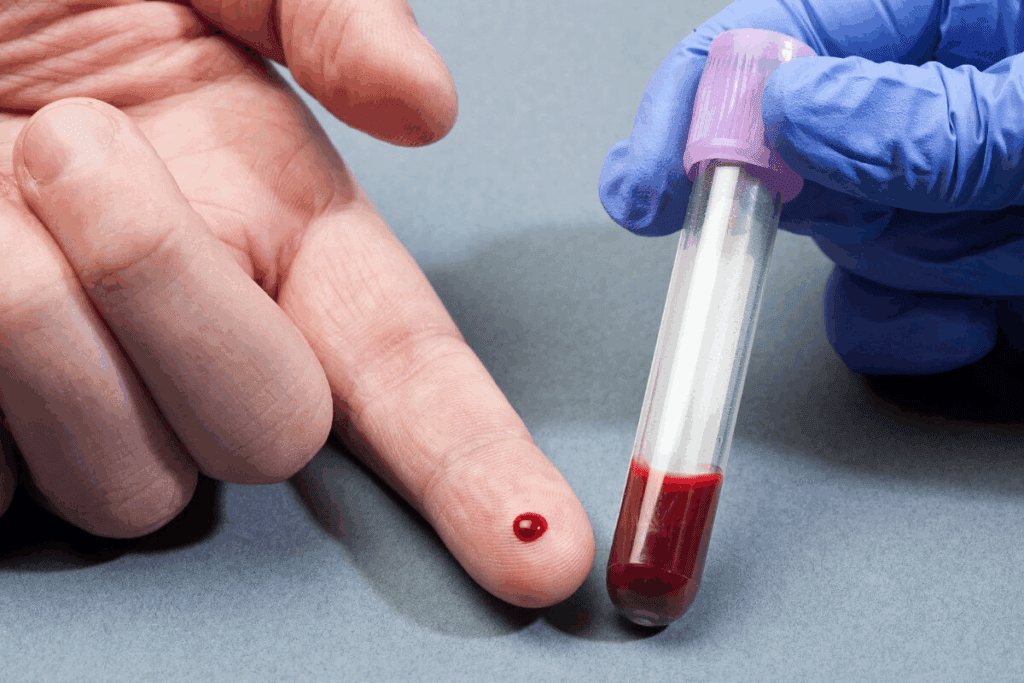Last Updated on November 17, 2025 by Ugurkan Demir

Where is bone marrow found in the human body? At Liv Hospital, we know how vital bone marrow is for overall health. This soft, spongy tissue sits inside most bones and plays a key role in producing blood cells and platelets.
In adults, bone marrow is mainly found in the pelvis, vertebrae, ribs, sternum, and the upper ends of the thigh and arm bones. It’s the body’s blood cell factory, creating billions of new cells each day.
There are two main types of bone marrow — red and yellow. Understanding where bone marrow is found and how these types differ helps doctors diagnose and treat many health conditions.

Bone marrow is key to how our bodies make blood cells and keep bones healthy. It’s a soft, spongy tissue inside bones. It’s vital for our health and survival.
Bone marrow is the soft tissue inside bones. It has hematopoietic cells for blood cell production, marrow adipose tissue for fat storage, and supportive stromal cells for structure. Experts say, “Bone marrow is the main place for new blood cell creation” (Dana-Farber). This mix allows it to do its important jobs.
Bone marrow’s main job is making blood cells, like red and white blood cells and platelets. This is called hematopoiesis. It’s key for oxygen delivery, fighting infections, and blood clotting. It also stores fat for energy.
Bone marrow has a network of blood vessels for nutrients and oxygen. It’s full of hematopoietic stem cells for blood cell types. Its makeup changes with age and need.
Bone marrow is a vital organ for our health. It makes blood cells and stores fat, making it essential for our well-being.

Bone marrow is a key part of our bodies. It’s found in many bones and is vital for our health. Knowing where it is helps us understand its importance.
Bone marrow is in many bones, helping us stay healthy. In adults, it’s mainly in the ribs, vertebrae, sternum, and pelvis. The hip bones, sternum, ribs, vertebrae, and skull are where red marrow is found.
The pelvis, vertebrae, and sternum are key places for bone marrow in adults. These bones have a lot of red marrow. This is where blood cells are made.
Bone marrow is also in the ribs, skull, and long bones. Long bones have more yellow marrow in adults. But, they also have red marrow, mainly in the top parts of the femur and humerus.
| Bone | Type of Marrow | Function |
| Pelvis | Red Marrow | Blood Cell Production |
| Vertebrae | Red Marrow | Blood Cell Production |
| Sternum | Red Marrow | Blood Cell Production |
| Ribs | Red Marrow | Blood Cell Production |
| Long Bones (e.g., Femur, Humerus) | Yellow Marrow (mainly), Red Marrow (proximal ends) | Fat Storage, Blood Cell Production (in proximal ends) |
Knowing where bone marrow is in our bodies is important. It helps us understand its role in health. It also aids in diagnosing and treating blood disorders.
It’s important to know the difference between red and yellow bone marrow. They play key roles in our body. Bone marrow helps make blood cells and stores fat.
Red bone marrow makes blood cells like red and white blood cells and platelets. It has hematopoietic stem cells that turn into these cells. Red bone marrow is full of blood vessels.
Yellow bone marrow is mostly fat. It has mesenchymal stem cells that can become different types of cells.
Red bone marrow is in the pelvis, vertebrae, sternum, and ribs. In adults, it’s mainly in flat bones and long bone ends. Yellow bone marrow is in long bone shafts.
| Type of Bone Marrow | Primary Locations | Main Functions |
| Red Bone Marrow | Pelvis, vertebrae, sternum, ribs | Blood cell production |
| Yellow Bone Marrow | Shafts of long bones | Fat storage, energy reserve |
At birth, most bone marrow is red. As we get older, some turn yellow. This change is natural. But, in severe anemia, yellow marrow can turn back to red to make more blood cells.
Red bone marrow is key to making blood cells. It’s a complex tissue full of blood vessels and different cells. These cells, like hematopoietic stem cells, are vital for blood cell production.
Red bone marrow is made of myeloid tissue. This tissue is rich in blood vessels and various cells. It includes a network of reticular fibers and cells, like hematopoietic stem cells, which make blood cells.
Hematopoietic stem cells are found in red bone marrow. They produce all blood cells, like red and white blood cells, and platelets. These stem cells can turn into different blood cells, keeping our blood healthy.
The process of making blood cells, called hematopoiesis, is complex. It involves many cell types and growth factors working together. Hematopoietic stem cells can renew themselves and turn into different blood cells, keeping our blood healthy.
In adults, red bone marrow is mainly in flat bones and the ends of long bones. The flat bones include the pelvis, vertebrae, sternum, and ribs. The ends of long bones, like the femur and humerus, also have red bone marrow.
Red bone marrow is in the spongy tissue of bones. This tissue is full of blood vessels and a network of cells. Knowing where red bone marrow is in adults helps us understand blood cell production and blood disorders.
Yellow bone marrow is filled with fat and is key to our health. It’s mainly in the long bones and helps keep us healthy.
Yellow bone marrow is mostly fat cells, which store energy. This makes it yellow. It’s different from red bone marrow, which makes blood cells.
The fat in yellow bone marrow changes with age and health. It’s a big energy storage spot in our bodies.
Yellow bone marrow has mesenchymal stem cells. These cells can become different types of cells. They help fix and grow tissues.
These cells are important for fixing bones and cartilage. They help keep our bones and cartilage healthy.
Yellow bone marrow is mostly in long bones like the thigh and upper arm bones. It’s more common in adults than in younger people.
It’s also found in other bones, but less often. Its spread changes with age and how many of blood cells we need.
In adults, flat bones like the pelvis, sternum, and ribs hold a lot of bone marrow. These bones are key to making blood cells. We’ll look at why flat bones are important for bone marrow and their role in health.
Flat bones are full of red bone marrow, which makes blood cells. The pelvis, sternum, and ribs have a lot of cancellous bone. This type of bone is spongy, perfect for blood-making cells.
Red marrow in flat bones is very important. It’s where blood cells, like red and white blood cells and platelets, are made. The pelvis, being big, plays a big role in this.
The pelvis is a main spot for red bone marrow in adults. Pelvic bone marrow makes a lot of the body’s blood cells. The pelvis’s large area is key to making blood cells.
We’ll now talk about the importance of bone marrow in the sternum and ribs.
Bone marrow in the sternum and ribs is very important for health. Sternal bone marrow is often used for tests because it’s easy to get to. Rib marrow, though less used, is also important for making blood cells.
| Location | Significance | Clinical Relevance |
| Pelvis | Primary site for red marrow | Major contributor to blood cell production |
| Sternum | Accessible for bone marrow biopsies | Used in diagnosing blood disorders |
| Ribs | Significant site for hematopoiesis | Less commonly accessed for clinical procedures |
In conclusion, flat bones like the pelvis, sternum, and ribs are vital for bone marrow and blood cell making. Knowing their role helps us understand the blood-making system better.
The femur, humerus, and other long bones have bone marrow inside. This tissue is vital and has many roles. Long bones are longer than they are wide, making room for marrow.
The medullary cavity is the middle part of long bones where marrow lives. It’s surrounded by compact bone that supports and protects the marrow.
The medullary cavity is filled with bone marrow, which can be either red or yellow, depending on its composition and function. Red marrow makes blood cells. Yellow marrow is mostly fat, acting as an energy storage.
In adults, red and yellow marrow are spread differently in long bones. The epiphyses (the ends) have red marrow. The diaphysis (the middle) has yellow marrow.
| Location | Type of Marrow | Function |
| Epiphyses (Ends of long bones) | Red Marrow | Hematopoiesis (Blood cell production) |
| Diaphysis (Shaft of long bones) | Yellow Marrow | Energy reserve (Fat storage) |
The mix of red to yellow marrow changes with age. Babies and young kids have more red marrow for blood cell needs. As we get older, more of this red marrow turns into yellow.
This change from red to yellow marrow is normal. But it can switch back if we lose a lot of blood or have severe anemia.
Bone marrow changes throughout our lives, switching between red and yellow types. This flexibility is key to making blood cells as needed.
Yellow marrow can turn back into red when the body needs more blood cells. This shows how our bodies can adjust to different needs.
Yellow marrow, full of fat cells, can change into red marrow. This is vital for making more blood cells when needed.
The change involves waking up hematopoietic stem cells. It also sets up the right cells and growth factors for blood cell making.
Several situations can make yellow marrow turn back to red. These include severe anemia, significant blood loss, and infections needing more blood cells.
In these cases, the body calls for more blood-making. Yellow marrow in some bones then turns to red to meet this need.
The change from yellow to red marrow is complex. It starts with special signals for blood-making.
As it goes on, fatty tissue in yellow marrow is replaced by blood-making cells. This shows our body’s amazing ability to adjust to needs.
Bone marrow is key to our health. It makes blood cells and stores stem cells. These cells can turn into different types. It’s vital for both finding and treating diseases.
Bone marrow disorders can harm its function. This leads to health problems. Leukemia, lymphoma, and aplastic anemia are examples. They stop the bone marrow from making healthy blood cells.
Understanding these disorders is key to finding good treatments. Leukemia, for example, makes too many bad white blood cells. This can cause anemia, infections, and bleeding.
Other issues include myelodysplastic syndromes and myeloproliferative neoplasms. These show how important bone marrow is for blood health.
Diagnostic tests like aspiration and biopsy are vital. Bone marrow aspiration takes a sample from the hip bone to check cells. It helps see if blood cells are being made right.
A bone marrow biopsy takes a bone tissue sample. It looks at the bone marrow’s structure and cells. These tests are key for diagnosing diseases like leukemia and lymphoma.
Bone marrow transplantation saves lives for severe diseases. It replaces bad bone marrow with healthy stem cells. This has changed how we treat blood cancers and other diseases.
Stem cell harvesting collects stem cells for transplantation. These cells can become different types of cells. They’re used in research for treating many diseases.
We’ve looked into how important bone marrow is in our bodies. It’s found in our bones and helps make blood cells and stores fat. Knowing the difference between red and yellow marrow is key to understanding its role.
Red bone marrow makes blood cells, which are essential for life. On the other hand, yellow bone marrow holds fat and has stem cells that can turn into different cells. The type of marrow we have changes as we age and based on our health.
In summary, bone marrow is vital for our health. It makes blood cells and stores fat. This article aims to give a clear view of bone marrow, its role, and its importance in our bodies.
There are two types of bone marrow: red and yellow. Red marrow makes blood cells. Yellow marrow stores fat.
Bone marrow is in many bones. This includes the pelvis, vertebrae, sternum, ribs, skull, and long bones.
Red marrow makes blood cells. Yellow marrow stores fat and energy.
In adults, red bone marrow is in the pelvis, vertebrae, sternum, and ribs. It’s also in the long bones.
Yellow marrow stores fat for energy. It also has stem cells that can become different cell types.
Yes, yellow marrow can turn back to red marrow. This happens in severe anemia or blood loss.
Bone marrow is key in diagnosing and treating blood disorders. This includes leukemia, lymphoma, and anemia.
Bone marrow aspiration and biopsy are used. They help diagnose and monitor blood-related conditions.
Hematopoietic stem cells in red marrow make all blood cells. This includes red blood cells, white blood cells, and platelets.
Flat bones like the pelvis, sternum, and ribs have more red marrow. They have a bigger surface area for making blood cells.
At birth, most marrow is red. But as we age, some red marrow turns to yellow. The mix of red and yellow marrow changes with age, health, and blood cell needs.
Subscribe to our e-newsletter to stay informed about the latest innovations in the world of health and exclusive offers!